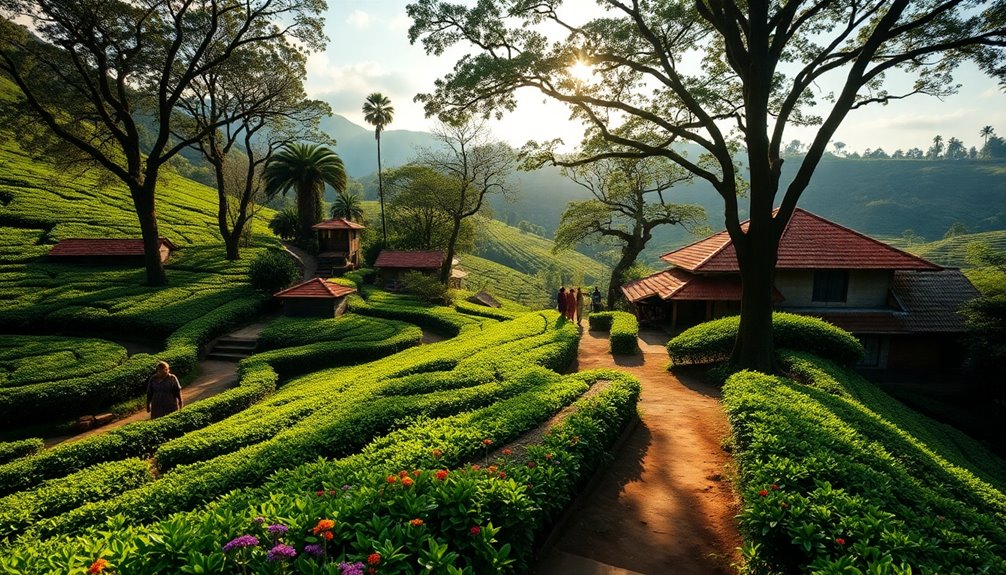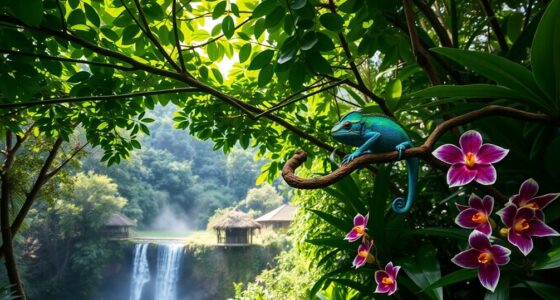Sri Lanka's green getaways offer you a unique blend of breathtaking nature and rich culture. You can explore diverse landscapes, from lush jungles to stunning coastlines, while engaging in sustainable tourism practices. Join wildlife safaris in national parks, or take part in organic farm tours that connect you to local communities. Use eco-friendly transportation options, like electric tuk-tuks, to reduce your carbon footprint. Participate in community-led reforestation projects, enriching both the environment and local economies. It's a journey where every experience deepens your appreciation for this beautiful island—discover even more of what awaits you just ahead.
Key Takeaways
- Explore Sri Lanka's national parks like Wilpattu and Horton Plains for wildlife safaris and endemic species in scenic natural landscapes.
- Engage in community-based tourism initiatives that promote cultural exchange and support local artisans, enhancing both economic empowerment and cultural heritage.
- Participate in sustainable practices, such as organic farm tours and eco-friendly lodge stays, that connect travelers with nature and local communities.
- Experience the vibrant biodiversity of coastal waters, ideal for marine activities like whale watching, while appreciating sustainable tourism efforts.
- Discover local crafts through workshops in batik painting and mask-making, fostering a deeper connection to Sri Lanka's rich cultural landscape.
Introduction
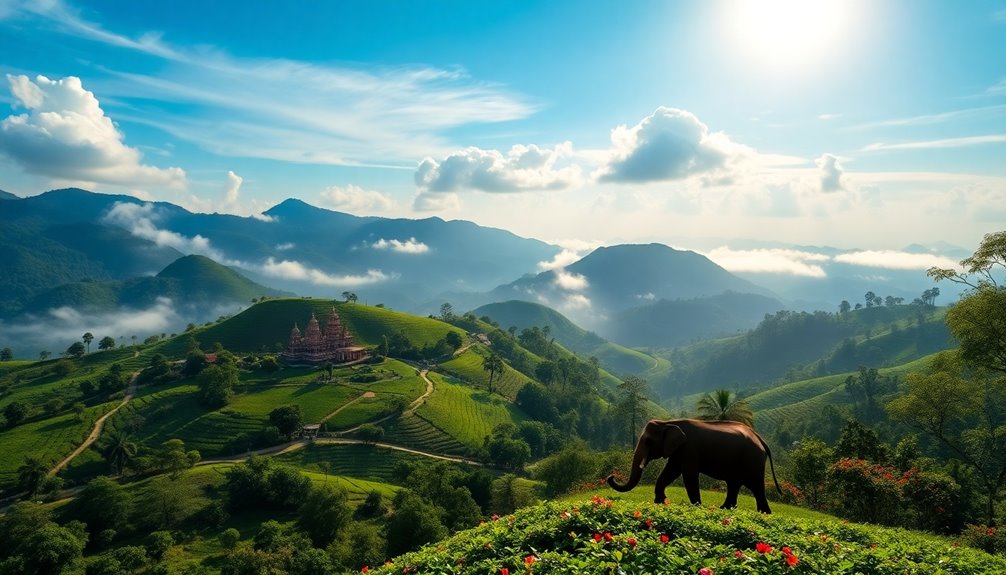
When you think of Sri Lanka, picture a vibrant tapestry of ecosystems and breathtaking landscapes.
This island is packed with biodiversity hotspots, each offering unique experiences that connect you to nature.
Biodiverse Ecosystems and Landscapes
Sri Lanka's diverse landscapes and rich ecosystems offer a captivating experience for nature lovers and adventure seekers alike.
You'll find yourself exploring biodiverse ecosystems, from the misty cloud forests of Horton Plains to pristine beaches along the coast.
Imagine embarking on wildlife safaris in Wilpattu National Park, where elephants roam freely and untouched wilderness thrives.
With approximately 26% of its flora and fauna being endemic, you might encounter unique species like the Sri Lankan leopard and the purple-faced langur.
Don't forget to visit one of the eight UNESCO World Heritage Sites, where nature intersects with cultural heritage.
Each destination showcases Sri Lanka's commitment to preserving its natural treasures while promoting sustainable tourism that benefits local communities.
Preserving Unique Biodiversity Hotspots
As you delve into Sri Lanka's unique biodiversity hotspots, you'll discover that preserving these areas is crucial for maintaining the island's rich natural heritage.
With over 26% of its land designated as protected areas, Sri Lanka boasts national parks and wildlife reserves that nurture extraordinary wildlife and diverse ecosystems.
For instance, Wilpattu National Park is home to the elusive Sri Lankan leopard, while Horton Plains National Park shelters endemic species like sambar deer.
The coastal waters are vital for marine biodiversity, offering chances to spot majestic blue whales.
Conservation efforts, including eco-friendly lodges and community-based tourism, are key in protecting these habitats and promoting sustainable practices, ensuring that future generations can experience Sri Lanka's incredible biodiversity.
Travel From India to Destination
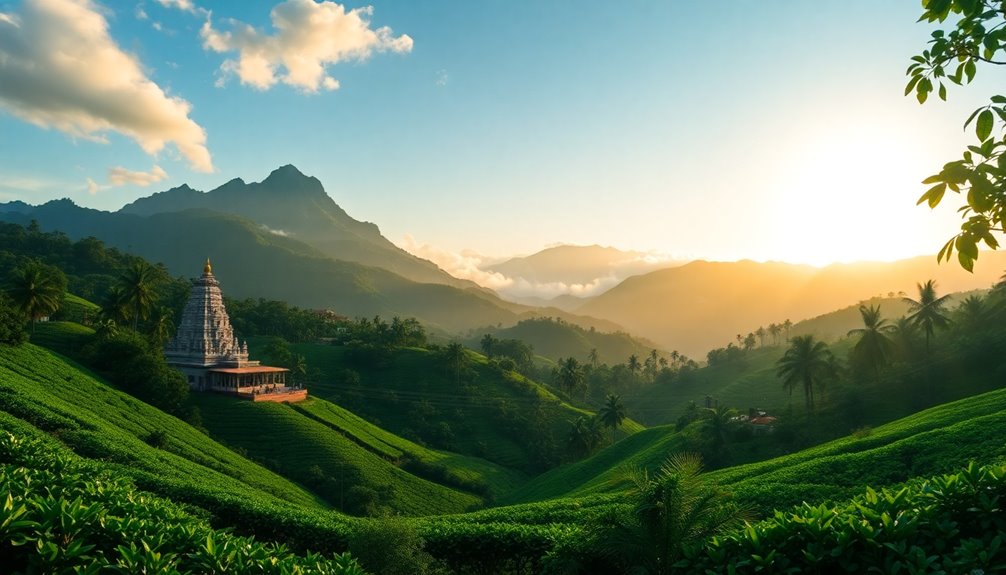
You can easily reach Sri Lanka from India with direct flights from cities like Chennai, Mumbai, and New Delhi, taking just 1.5 to 3 hours.
Once you land at Bandaranaike International Airport in Colombo, you'll find plenty of options to explore the island, including local transportation like tuk-tuks.
If you prefer a scenic route, consider the ferry services from Tamil Nadu to Jaffna for a unique travel experience.
Flights to Sri Lanka
Wondering how to reach the stunning landscapes of Sri Lanka from India? You'll be pleased to know that Sri Lanka is home to breathtaking scenery and vibrant culture, and getting there's a breeze.
Direct flights from major Indian cities like Chennai, Bengaluru, and Mumbai to Colombo typically take just 1.5 to 3 hours. Airlines such as SriLankan Airlines and IndiGo offer flexible schedules, making your travel planning easy.
Once you land at Bandaranaike International Airport, you'll find connecting flights to explore more of the island. Don't forget to check the visa requirements—Indian travelers need an Electronic Travel Authorization (ETA), which you can quickly obtain online.
With round-trip fares often starting around INR 5,000 to 10,000, your adventure awaits!
Flights From London to Colombo
For those planning to travel from London to Colombo, the journey typically spans around 10 to 12 hours, making it a significant but manageable long-haul experience.
You'll find flights from London to Colombo offered by major airlines like British Airways, SriLankan Airlines, and Emirates, ensuring a range of options for your schedule.
The distance of approximately 5,400 miles (8,690 kilometers) might seem daunting, but many travelers enjoy the journey.
Colombo's Bandaranaike International Airport (CMB) serves as your gateway to Sri Lanka, connecting you to various domestic destinations.
Plus, you can often snag competitive fares, especially during off-peak seasons, with average round-trip prices ranging from £500 to £800, making this trip all the more appealing.
Direct Flights From Australia
How easy is it to reach Sri Lanka from Australia?
You'll find it quite convenient, thanks to direct flights from Australia that typically take around 10 to 12 hours. Airlines like SriLankan Airlines and Qantas operate frequent routes from major cities such as Sydney, Melbourne, and Perth.
While some flights might connect through hubs like Singapore or Kuala Lumpur, they ultimately lead you to Colombo, Sri Lanka's vibrant capital. This accessibility makes it simple to explore Sri Lanka's diverse landscapes and rich cultural heritage.
If you're considering a stopover, connecting flights from Indian cities like Chennai and Mumbai also provide direct access to Colombo.
Just remember to check for seasonal variations in flight availability and pricing, especially during peak travel seasons.
Tuk-Tuk Rides Around Towns
After reaching Colombo, exploring the towns of Sri Lanka becomes an adventure in itself, and there's no better way to do it than by hopping into a tuk-tuk. These vibrant, three-wheeled vehicles let you immerse yourself in local life, providing an exhilarating way to explore hidden gems and lively street scenes. Fares are budget-friendly, typically ranging from LKR 30 to LKR 100 per kilometer, making it easy to navigate through traffic.
| Experience | Description | Emotion |
|---|---|---|
| Ride the Tuk-Tuk | Feel the wind in your hair | Excitement |
| Meet Locals | Engage with friendly locals | Connection |
| Discover Culture | Visit historical attractions | Awe |
| Explore Hidden Gems | Find unique spots off the beaten path | Joy |
| Eco-Friendly Travel | Support sustainable tourism | Satisfaction |
Hop in and let the adventure begin!
Sustainable Wildlife Encounters
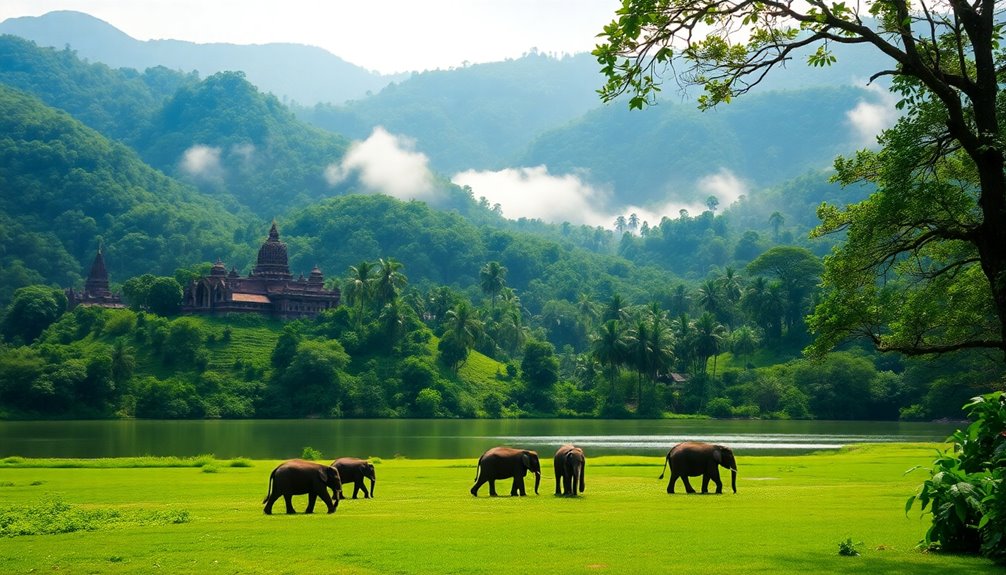
When you explore Sri Lanka's wildlife, consider responsible viewing tours that respect animal habitats and promote conservation.
You can also enhance your experience with organic farm tours, connecting with local communities and sustainable practices.
Staying at eco-friendly lodges made from local materials will further enrich your journey while supporting the environment. Additionally, engaging in activities that promote eco-friendly practices can enhance your overall experience and contribute positively to both the local community and environment.
Responsible Wildlife Viewing Tours
As you explore Sri Lanka's breathtaking landscapes, responsible wildlife viewing tours offer you the chance to witness the island's incredible biodiversity up close.
You'll experience diverse wildlife in their natural habitats, guided by experts who enhance your understanding of local ecosystems.
- Spot majestic leopards and elephants in Yala and Udawalawe.
- Enjoy private whale-watching cruises from Mirissa Harbor.
- Participate in small group tours for a personalized experience.
- Travel in eco-friendly open-top Toyota Land Cruisers, minimizing disturbance to wildlife.
These eco-friendly opportunities not only create unforgettable memories but also promote conservation efforts.
Organic Farm Tours
Discovering Sri Lanka's organic farm tours opens up a world of sustainable agriculture that highlights the island's commitment to eco-friendly practices.
You'll explore vibrant farms focusing on sustainable agricultural practices, where tropical fruits, vegetables, and herbs flourish. Engaging in hands-on activities like planting and harvesting, you'll prepare traditional Sri Lankan dishes using fresh, organic ingredients right from the farm.
Many farms also embrace permaculture, promoting biodiversity and a healthier ecosystem, which reduces environmental impact. During your visit, you might spot local fauna, such as colorful butterflies and diverse bird species, thriving in these organic settings.
Sustainable Lodges With Local Materials
After exploring the vibrant world of organic farm tours, you'll find that sustainable lodges in Sri Lanka offer an equally immersive experience in eco-friendly living.
These lodges utilize local materials like reclaimed wood and bamboo, reducing carbon footprints while bolstering local economies. By choosing these accommodations, you directly contribute to wildlife conservation efforts.
Consider these emotional connections:
- Experience authentic wildlife encounters with local experts.
- Participate in tree planting and wildlife monitoring initiatives.
- Enjoy energy-efficient designs that support a sustainable future.
- Support local craftsmanship, preserving cultural heritage.
Eco-Friendly Transportation Options
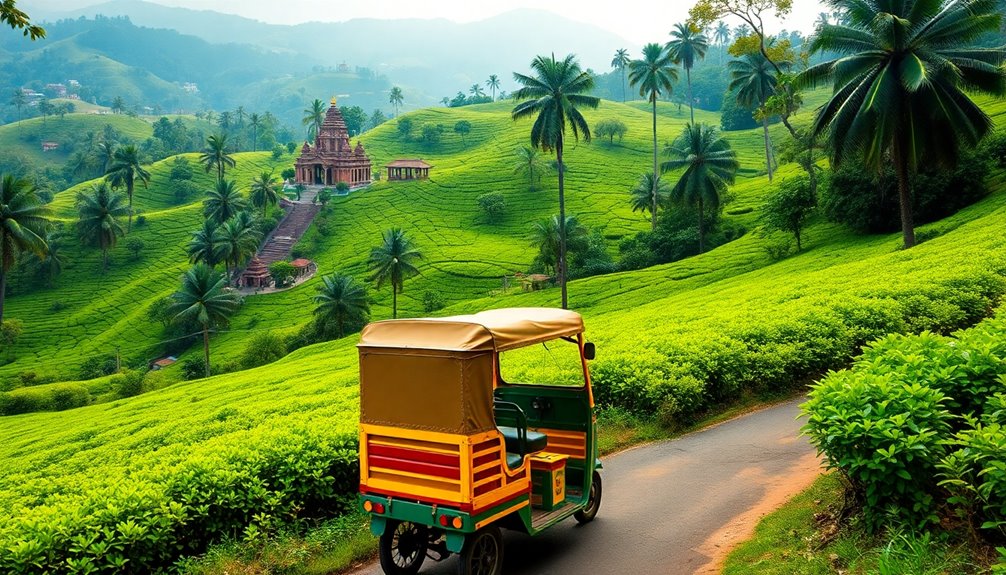
When exploring Sri Lanka, you'll find a variety of eco-friendly transportation options that make it easy to travel sustainably.
Electric tuk-tuks and bicycle rentals are popular choices, allowing you to reduce your carbon footprint while experiencing the beauty of the island. The expanded public transport system, featuring energy-efficient trains and buses, is another great way to get around.
For a more immersive experience, consider joining guided eco-tours that promote walking or cycling through stunning natural landscapes. Plus, carpooling and ride-sharing services are gaining traction, helping to cut down on traffic congestion.
With government initiatives supporting biofuels and electric vehicles, you can enjoy a greener tourism experience while exploring all that Sri Lanka has to offer.
Community-led Reforestation Projects
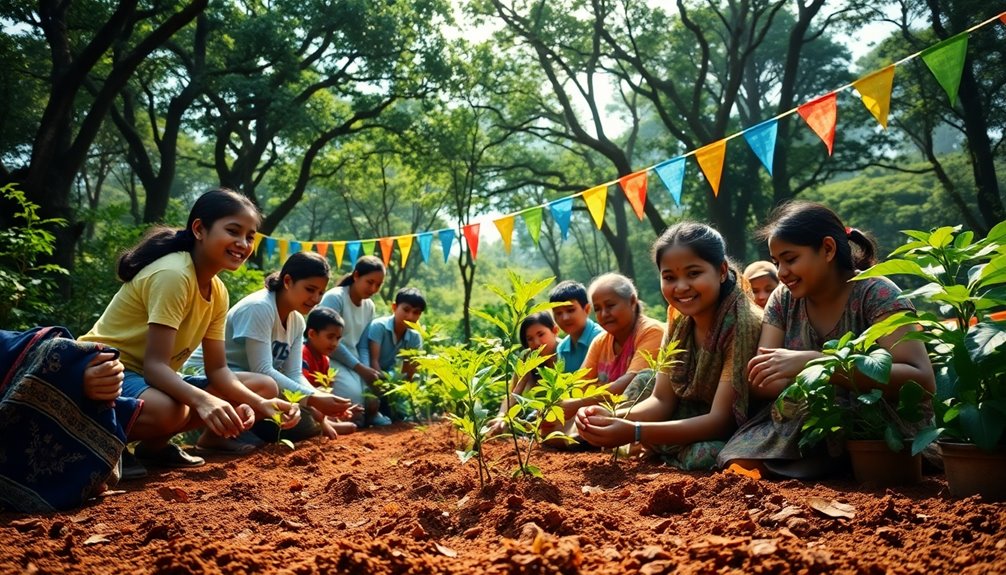
In Sri Lanka, community-led reforestation projects are making a real impact, thanks to the collaboration between local groups and NGOs.
You'll see how these efforts not only restore native ecosystems but also strengthen cultural ties and provide economic opportunities.
As you explore these green initiatives, you'll discover the vital role they play in sustainable development and environmental preservation.
Government and NGO Efforts
While the challenges of deforestation and climate change loom large, community-led reforestation projects in Sri Lanka are making a significant impact.
Collaborating with local NGOs, the Sri Lanka Forest Department engages communities to plant millions of native trees, enhancing biodiversity and ecosystem resilience. Initiatives like "Greening Sri Lanka" have mobilized thousands, resulting in over 3 million trees planted.
- You're helping restore degraded landscapes.
- You're creating habitats for diverse wildlife.
- You're empowering locals through eco-tourism.
- You're leaving a greener legacy for future generations.
Educational programs further raise awareness, inviting you to participate in these vital conservation efforts. These projects not only contribute to sustainable practices but also foster community involvement and resilience against climate change.
Together, we can nurture the environment while reaping economic benefits, ensuring a sustainable future for all.
Community and Cultural Sustainability
Building on the momentum of government and NGO efforts, community-led reforestation projects in Sri Lanka play a vital role in promoting both environmental and cultural sustainability. By involving local communities in planting and maintaining over 50,000 trees in just three years, these initiatives enhance biodiversity while fostering a sense of ownership. Your participation not only combats deforestation but also supports local eco-tourism and sustainable agriculture.
| Benefits | Impact |
|---|---|
| Restores native forests | Enhances local biodiversity |
| Promotes environmental awareness | Supports community livelihoods |
| Fosters cultural heritage | Creates eco-tourism opportunities |
Engaging communities in reforestation helps balance nature and culture, ensuring a thriving ecosystem for future generations.
Monsoon Season for Lush Landscapes
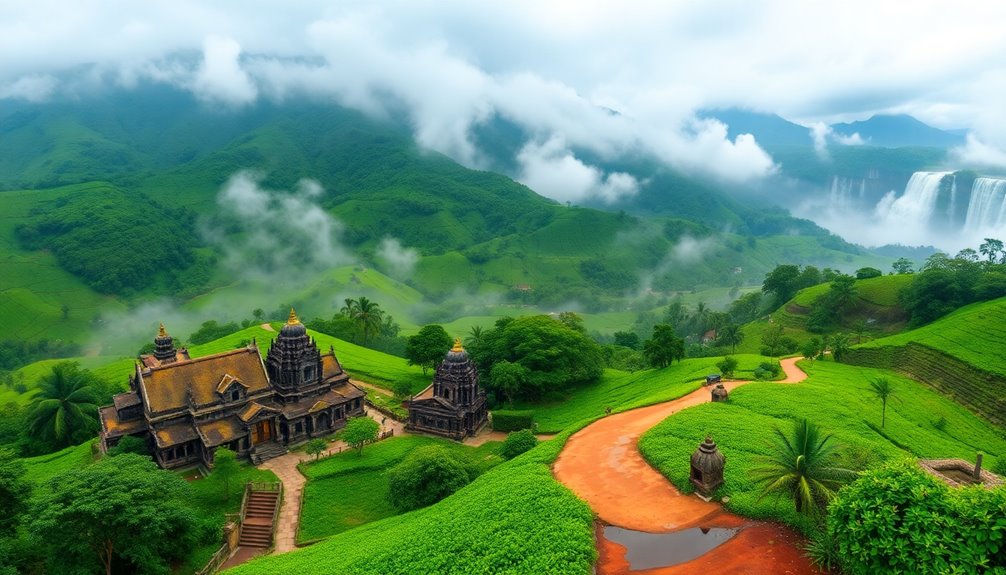
When the monsoon season rolls in from May to September, you'll see Sri Lanka transform into a vibrant paradise.
The heavy rains not only enhance the lush greenery but also create the best conditions for wildlife viewing, especially in national parks.
As you explore, don't miss the breathtaking waterfalls that swell during this time, offering a unique backdrop for your adventures.
Best Months for Wildlife Viewing
As the monsoon season sweeps across Sri Lanka from May to September, the landscapes transform into a lush paradise, making it the perfect time for wildlife viewing.
During these months, national parks like Yala and Udawalawe burst with wildlife activity as animals flock to newly formed water sources.
You'll witness:
- Elephants bathing in vibrant greenery
- Sambar deer wandering through enriched ecosystems
- Leopards stealthily prowling in Wilpattu National Park
- A dazzling array of migratory bird species gracing the skies
The rains rejuvenate the flora and fauna, creating a rich tapestry of life.
This is your chance to see nature at its most vibrant and experience unforgettable encounters with Sri Lanka's diverse wildlife.
Don't miss out!
Monsoon Rains Enhance Greenery
While the monsoon season transforms Sri Lanka's landscapes into a lush wonderland, it also creates an enchanting atmosphere for nature lovers.
From May to September, the monsoon rains rejuvenate the island, enhancing its natural beauty. You'll witness vibrant greenery across tea plantations, forests, and agricultural fields, especially in the western and southern regions.
The increased rainfall supports the rich biodiversity in national parks like Yala and Udawalawe, where wildlife thrives in the flourishing surroundings.
Horton Plains becomes a picturesque paradise, with misty cloud forests and blooming flora, perfect for photographers and hikers alike.
The rejuvenated landscapes during this season offer ideal conditions for eco-tourism, inviting you to experience Sri Lanka's breathtaking lush landscapes firsthand.
How to Make Your Trip More Sustainable
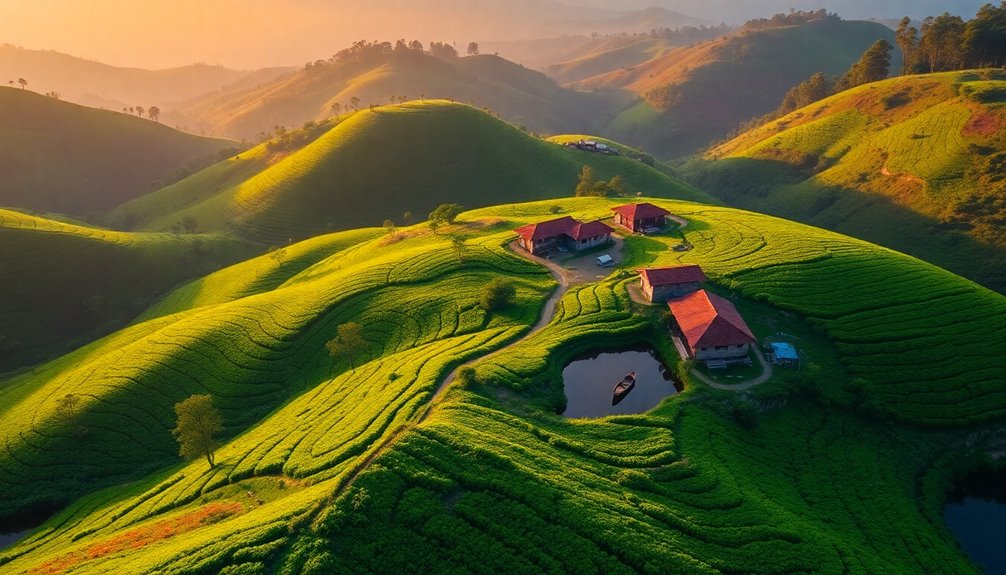
To make your trip to Sri Lanka more sustainable, consider packing biodegradable toiletries and supplies to reduce waste.
Supporting local artisans by purchasing handmade crafts not only benefits the community but also gives you unique souvenirs to remember your journey.
Biodegradable Toiletries and Supplies
Choosing biodegradable toiletries and supplies can significantly enhance your sustainability efforts while traveling in Sri Lanka.
By opting for eco-friendly options, you'll help protect the environment and support local communities. Consider these impactful choices:
- Use shampoo bars instead of plastic bottles.
- Pack bamboo toothbrushes to reduce plastic waste.
- Bring reusable cloth bags for shopping.
- Carry a stainless steel water bottle to avoid single-use plastics.
Many eco-friendly accommodations in Sri Lanka offer sustainable toiletries made from natural ingredients, aligning with your commitment to responsible tourism.
By supporting brands that prioritize biodegradable products, you're not only preserving the island's stunning ecosystems but also contributing to local conservation efforts.
Make a difference during your travels, and enjoy the beauty of Sri Lanka guilt-free!
Support Local Artisans
Supporting local artisans not only enriches your travel experience but also plays a crucial role in preserving Sri Lanka's vibrant cultural heritage.
By choosing to support local artisans, you help sustain traditional crafts like handloom textiles and pottery, vital to the island's identity. When you purchase handmade products directly, more proceeds remain in the local economy, fostering sustainable practices and economic empowerment.
Engaging in workshops, like batik painting or mask-making, gives you a unique insight into these techniques while supporting their craft. Additionally, consider incorporating traditional decorations from local artisans into your travel plans to further appreciate the cultural significance of these crafts.
Explore local markets and craft fairs in cities like Galle and Colombo to discover authentic Sri Lankan art.
Participating in community-based tourism initiatives strengthens your connection with locals and encourages responsible travel, enriching both your journey and theirs.
Frequently Asked Questions
What Is Sri Lanka's Cultural Landscape?
Sri Lanka's cultural landscape is a vibrant tapestry woven from over 2,000 years of history.
You'll find influences from South Indian and colonial European civilizations, visible in its UNESCO World Heritage Sites like Anuradhapura and Polonnaruwa, showcasing stunning stupas and intricate carvings.
The island's strong Buddhist traditions come alive at the Temple of the Tooth in Kandy, while festivals like the Esala Perahera celebrate its diverse heritage with lively music, dance, and craftsmanship.
What Is the Nature Beauty of Sri Lanka?
When you think of wild, untouched landscapes, Sri Lanka's nature beauty stands out.
You'll find lush tea plantations cascading down hills, contrasting with the rugged cloud forests of Horton Plains.
The pristine beaches invite relaxation, while the thriving wildlife in Wilpattu National Park captivates your spirit.
Each ecosystem, from vibrant coral reefs to majestic elephants, tells a story of diversity, making Sri Lanka a true paradise for nature lovers like you.
What Is Sri Lanka Mostly Known For?
Sri Lanka's mostly known for its incredible biodiversity and rich cultural heritage.
You'll find stunning landscapes, from lush mountains to pristine beaches. The island boasts iconic wildlife, including elephants and leopards, especially in national parks like Yala.
You can explore ancient cities and UNESCO World Heritage Sites that showcase its historical significance.
Don't forget to indulge in its vibrant cuisine, with rice and curry being a staple that reflects the island's diverse flavors.
What Makes Sri Lanka Beautiful?
Did you know that Sri Lanka is home to over 400 species of birds, making it a paradise for birdwatchers?
Its beauty lies in the diverse landscapes, from stunning beaches to lush green hills.
You'll be captivated by ancient temples and vibrant festivals that showcase its rich culture.
The island's wildlife, including the majestic Sri Lankan leopard, adds to the allure.
Exploring its breathtaking scenery and cultural heritage will leave you in awe.
Conclusion
As you wander through Sri Lanka's vibrant green landscapes, from lush jungles to serene beaches, you'll discover a beautiful blend of culture and nature. Each step you take echoes with the sounds of wildlife, while the warm smiles of local communities invite you to connect. Embrace sustainable travel, and let your adventure leave a gentle footprint on this paradise. Together, you can help preserve its breathtaking beauty for generations to come, ensuring every experience is as enriching as the last.

